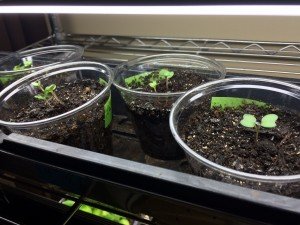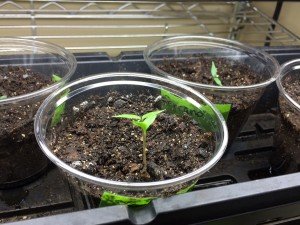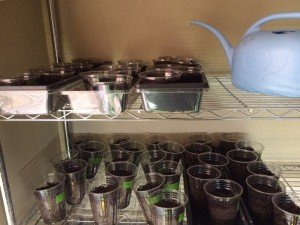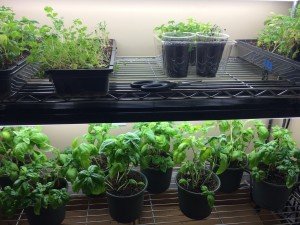The last frost date for this area passed without incident on April 9th and today was my first day home to survey the perennials and sow some annuals.I'm just going to say it, my over-wintered herb garden is just darned pretty this spring. And I am beside myself that the chives are not just alive but thriving! After years of refusing to grow for me, they are vigorous and even blooming.I was also ecstatic to see the blueberries bountifully in bloom!Last year the blueberries were conned into blooming by the false spring and a hard, late frost killed most of the flowers. A feeble second bloom happened after the last frost but didn't amount to much.The strawberries were also a pleasant surprise, not just sporting a healthy head of blooms but some hard green strawberries already just waiting for the warmth of the sun to make them blush.I threw caution to the wind a few weeks ago and mixed up the assorted lettuce seeds I had on hand and sowed them thickly in 1/2 of a bed. I love the mix of the reds, greens and the little ones already wearing speckles.And lastly I laid down 18 rows of spinach in the front 3/4ths of these beds that will also host 2 tomato plants each in a few weeks.Ahhhhh...the gardener's Spring has finally sprung!
Read MoreFallow Season
Winter is a quiet time for the garden. The cooler temperatures and shorter days signal a change and the earth changes orientation from growth to conservation. The plants that continue to grow through the changing of the calendar year do so at a pace that resembles drowsy, hibernating animals. It is a necessary fallow season. A time to rest and restore between the endeavors of growing seasons. This is true for both garden and gardener.These were the thoughts turning over in my head yesterday as I tidied up the asparagus and herb beds, tucking them in for winter.
The herbs had overgrown in the last flush of fall so I corralled them to their respective sections with clippers and kept some nice sprigs of thyme, oregano and parsley for tonight's soup. Visually the thyme and the rosemary blend together both in person and photos so I think I will swap out the fast growing parsley and thyme next spring and let the rosemary continue to grow in the center of the bed.All that remains to close out my 2017 garden is to give the figs a much needed pruning and trim back the blueberry bushes a bit. It has been a quiet time for my garden and blog with the time normally spent growing, cooking and writing instead going to other endeavors this year. There is a little more time between now and spring temps here in the south. The last bit of the fallow season, with weeks that can be counted on hands now. My 2018 seed catalog has arrived and I am beginning to plan for the renewal.
Read MorePermaculture Summer
To create your own permaculture summer:
Start with a good variety of fruits, berries and herbs that pretty much take care of themselves year after year.
Add to that background of growth, some tender green leaves (lettuce and spinach will do nicely) and one hungry rabbit.
Voila! You are back to your permaculture staple of fruits, berries and herbs with no pesky greens to worry about.
This, in a nutshell, is my summer.The herbs bolted and are setting seed now. The strawberries are producing well but I haven't covered the bed so the birds are beating me to many of the berries.The tower of asparagus is holding up very nicely under the accumulating mass of growth and the asparagus themselves are inexplicably sending up sporadic spears (3 in the pic below).The figs are plentiful and beginning to ripen. The birds also beat me to the first fig of the year but they don't seem to have seen the one on the other side yet.The blackberries are ripening by the handful daily and the blueberries are plentiful, but stubbornly green.The rabbit problem appears to be solved so now I am just patiently waiting for August when I can plant more greens for fall.
Read MoreLaissez-faire Farming
The threat of winter weather pushed right up to the last frost date for my area this year. Add in my hectic schedule the past few weeks and the result is a late start on my spring garden, and some corners looking to be cut.These colorful lettuce varieties would normally be carefully planned and planted in their own distinct areas.This year I am deploying what I am calling a laissez-faire farming method of "mixed lettuces" saving a lot of time and proving that even lackadaisical farming sounds better in french.Seeding and watering these 9 square feet (around 100 plants) was the work of 5 minutes.I have to give a quick shout out to the oregano photo bombing the picture above (bottom and right of garden bed). This now feral oregano self seeded the area around it two years ago when I had the herb planted in this box. It is so thick and lovely year round that I am tempted to use it as a ground cover along paths.For the rest of my garden, this year I am doing a lot more grouping than normal, with all of a bed planted with spinach or radishes or edamame, allowing me to broadcast seeds and get everything started a little faster.Au revoir!
Read MoreSpring Again (Maybe)
The average last frost date for this area passed on April 4th but it has been an unusual spring with early season warming trends in February that encouraged strawberries and blueberries to bloom early followed by unsurprising freezes in early March that played havoc with the plants.My strawberry blooms mostly survived the hard freezes in March and these June Bearers are already showing off green fruits.The permaculture herb garden did very well over the winter, only dill and tarragon did not survive. The thyme is already blooming and the sage is just a step behind.Several asparagus spears were harvested in February then several more killed by one of the hard freezes, but they are loving the current weather and I am harvesting 5-7 spears every 2 days right now.I lost some blueberry blooms with the freezes, but they also seem to have rebounded more or less with new blooms coming in, though I anticipate a diminished harvest this year over last.Spring seems to be here to stay at last so it is time to start planting some annuals too!
Read MoreAutumn Recess
Autumn has arrived in North Carolina, bringing with it the final harvest of bell peppers, roma tomatoes and serrano peppers.The herb garden has brushed off the first few light freezes and stands ready to make meals fragrant and savory for months to come. I am confident that the thyme, oregano and sage will over winter well and hope that the french tarragon and parsley will also.Parsley is such a staple of fall and winter dishes that I have more growing on my deck. I have been poaching from the deck parsley for a few weeks thinking that it would not handle the frosts as well, but so far it is also doing wonderfully.In previous years I have repeatedly removed pine needles from the garden beds only to replace it with a different mulch. This year I have come to my senses and am embracing the pine trees taking care of mulching for me.Collards, carrots, cabbage and parsnips are tucked into their naturally (and effortlessly) mulched beds.The fall planting of sugar snap peas has been supplying tender pea shoots and now has peas forming as well.The hydroponic herbs were changed over 10 days ago to the varieties I know and love to cook with and are already doing quite well. I am growing 2 plantings each of my favorite basils and cilantros, 3 of the flat leaf parsley and just for fun I am trying to grow 2 red kales hydroponically.With the Super Bowl and attendant tomato starts almost 2 months away, this cozy, fall garden that is mostly taking care of itself feels like a recess.
Read MoreHerbal Remedy
My experiment with the front yard herb garden has come to a close.On Sunday I thinned my 150+ strawberry plants that were spread over two beds down to 32 first-year runners in one bed. Back in April I wrote about a New Zealand farmer that said first-year plants produce larger quantities of bigger berries and determined that I would try to save enough runners to have a fresh bed for 2017. This opened up a whole 4'x4' box to overwinter herbs in.Overall the herbs did fairly well in the front, though the bunnies enjoyed the french tarragon for a while this spring and the chives were eaten down to nubs repeatedly. I did a little research and it seems that the tarragon may over winter in my zone, and I am sure the sage and oregano will do fine. The rosemary is a maybe and I have no idea about the thyme or dill, but I planted everyone in a checkerboard pattern to allow for some sprawling and hopefully some self sowing for a perpetual herb garden.Once established, I will trim back the herbs and dry the cuttings for my fall/winter use and mulch the plants with leaves to retain heat, moisture and feed the soil.
Read MoreFarmin' the Front
For years I have been sporting an agricultural mullet - suburban-nice in the front and a garden-party in the back, but no more.Yesterday I ripped out the low growing juniper bush that was taking up half of the space between my sidewalk and front porch to make room for my 2016 herb garden. Soon this space will be growing french tarragon, rosemary, parsley, oregano, thyme, sage and if I am lucky, chives*. I will also be sprinkling in some Mother of Pearl Poppy flowers between my herb plantings to maximize the planting space for me and add visual interest for my suburban neighbors.I left the viburnum and nandina landscaping bushes in the back 1/2 of the space alone for now...* Does every gardener have a plant nemesis? Some varietal that stubbornly refuses to thrive despite trying year after year in different conditions? Mine is chives.
Soon this space will be growing french tarragon, rosemary, parsley, oregano, thyme, sage and if I am lucky, chives*. I will also be sprinkling in some Mother of Pearl Poppy flowers between my herb plantings to maximize the planting space for me and add visual interest for my suburban neighbors.I left the viburnum and nandina landscaping bushes in the back 1/2 of the space alone for now...* Does every gardener have a plant nemesis? Some varietal that stubbornly refuses to thrive despite trying year after year in different conditions? Mine is chives.
Fired Up For Summer
I know it's a bit early to be thinking about summer and fresh from the garden salsa, but the recipe below for Fire-Roasted (Cherry) Tomato Salsa from the very entertaining Chef John Mitzewich (Food Wishes) sent me back to my garden plan to make sure I plenty of cherry tomatoes started to enjoy this salsa all summer!My favorite recipes to make have at least some portion of the ingredients coming from my own garden and this one definitely fits the bill for being NearlyHomeGrown with cherry tomatoes, cilantro, oregano and serranos substituting for jalapenos as key ingredients.
Starting My Garden Early
While Punxsutawney Phil and the meteorologists work out their differing predictions for the end of winter, growers are already hard at work preparing for spring, summer and fall.January plant starts included cabbage, chili peppers, bell peppers and rosemary.
chili peppers, bell peppers and rosemary. Now that February has begun, the seed starting kicks into high gear with oregano, collards and lots and lots of tomatoes with 8 varieties and a total of 38 plants this year!
Now that February has begun, the seed starting kicks into high gear with oregano, collards and lots and lots of tomatoes with 8 varieties and a total of 38 plants this year! The new starts will welcome roommates in my growing nook for the cilantro and basil I grow indoors each winter. I purchased inexpensive shop lights, metal wire shelving units and florescent tubes 5 years ago so I never have to go a grey winter day without their bright colors and fresh flavors complimenting meals.
The new starts will welcome roommates in my growing nook for the cilantro and basil I grow indoors each winter. I purchased inexpensive shop lights, metal wire shelving units and florescent tubes 5 years ago so I never have to go a grey winter day without their bright colors and fresh flavors complimenting meals. The minimal, initial investment for the equipment has more than paid for itself already and now as my garden diversifies and the number of indoor starts continue to expand each year with no additional infrastructure costs to date, I consider this money extremely well spent.Happy Spring, whenever it comes :)
The minimal, initial investment for the equipment has more than paid for itself already and now as my garden diversifies and the number of indoor starts continue to expand each year with no additional infrastructure costs to date, I consider this money extremely well spent.Happy Spring, whenever it comes :)
The Expat Starter Garden
A dear friend is moving south of the border to live on the shores of Lake Chapala, said to have the second best climate on earth, behind only Atenas, Costa Rica. She wants to start a small garden there and was looking for suggestions.All of these suggestions do very well in both containers (both patio and raised bed) and in rich garden soil, making them versatile, low maintenance choices for a first time gardener.If you are only going to grow one thing, I think basil is a great place to start. It is easy to grow, abundantly productive and can be added to almost every meal you make or have for takeout. I prefer the sweet genovese varieties.If you are only going to grow two things, then basil and cilantro are my choices. Again, easy, abundant and can add a bright taste to any dish, homemade or otherwise. For warmer climates (mine included) try a slo bolt variety.Oregano and rosemary are also low maintenance but useful and abundant herbs for a first time gardener and experienced cook.If she wants to expand beyond herbs, spinach is a great choice for novices. Leaves can be taken as needed allowing the plant to continue growing, many fresh or cooked uses and easy to grow. Again, with warmer climates, a slo bolt variety would be best.After spinach, the chili pepper of your preferred spiciness range. I favor serranos. They are very abundant producers, impart a great flavor in addition to the heat they add to dishes and can be picked green or red depending on your heat preferences. Roasting ripe ones each time you grill and freezing them means delicious roasted peppers on hand year round.And then every gardener's pride and joy, tomatoes. For many of the same reasons, I would recommend cherry type tomatoes for the small scale gardener. They produce much more abundantly than slicing tomato varieties and due to their size can be dried or roasted and frozen for year round additions to meals.With just these 7 items, incorporating bounty fresh from the garden (or preserved from the garden) year round is easy and will work into everyone's favorite dishes.




